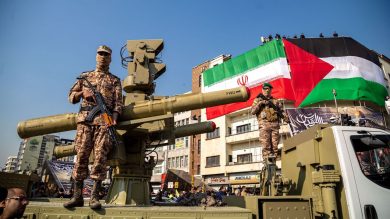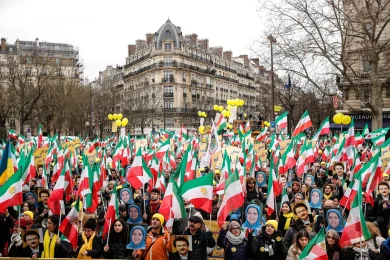In the struggle for democracy and human rights, Iranian women have emerged as the defiant leaders of resistance. Whether through street protests, activism, digital defiance, or legal advocacy, women in Iran are challenging the Islamic Republic’s oppressive system, particularly the Islamic Revolutionary Guard Corps (IRGC), which enforces strict gender apartheid and political repression.
From the Women, Life, Freedom movement to individual acts of defiance, women have become the face of resistance, demanding justice, equality, and an end to authoritarian rule. Despite the IRGC’s brutal tactics, including arrests, torture, and executions, Iranian women continue to lead, organize, and inspire change.
This analysis explores:
• The historical role of women in Iran’s resistance.
• The IRGC’s tactics to suppress women’s activism.
• The role of digital resistance and social media.
• The impact of global solidarity.
• Why women will shape the future of a free Iran.
1. A History of Women’s Resistance in Iran
A. Women Before and After the 1979 Revolution
Iranian women have historically played a major role in shaping political movements. Before the 1979 Islamic Revolution, women participated in:
• Educational and labor rights movements.
• The Constitutional Revolution (1905-1911).
• The 1953 movement against the coup that ousted Prime Minister Mossadegh.
However, the Islamic Republic reversed many of their gains, implementing:
• Mandatory hijab laws.
• Gender segregation in workplaces and universities.
• Restrictions on travel, marriage, and divorce rights.
Despite this, Iranian women have continuously resisted, and their struggle intensified in the 21st century.
B. Women in the Green Movement (2009) and Beyond
Women played a key role in the 2009 Green Movement, protesting election fraud and demanding civil rights. Though the regime violently suppressed the movement, it laid the foundation for:
• Women’s digital activism to bypass government censorship.
• The rejection of the hijab as a tool of state control.
• Greater participation in civil resistance movements.
The 2017-2018 economic protests and the 2019 fuel protests saw women at the forefront, demonstrating that their fight for gender equality was part of a larger fight for democracy.
2. How the IRGC Targets Women to Maintain Control
A. The IRGC’s Role in Enforcing Gender Oppression
The IRGC, as the regime’s main enforcer, has systematically targeted women through:
• Morality police enforcing the mandatory hijab.
• Digital surveillance and arrests of female activists.
• Torture, sexual violence, and forced confessions against detained women.
By controlling women’s bodies, choices, and freedoms, the IRGC aims to control society as a whole.
B. Violence and Intimidation Against Women Protesters
During protests, the IRGC and Basij forces have:
• Used brutal force against women demanding freedom.
• Imprisoned female activists, including Narges Mohammadi, Nasrin Sotoudeh, and Sepideh Gholian.
• Sexually assaulted detainees as a method of control and punishment.
Despite this, Iranian women have refused to back down, showing the world their determination for change.
3. The Role of Digital Resistance and Social Media
A. Women’s Digital Activism
Women activists have used social media as a tool for resistance, exposing:
• IRGC’s crimes against protesters.
• Government corruption and gender discrimination.
• Real-time footage of protests and crackdowns.
B. How the IRGC Tries to Silence Digital Resistance
The regime has responded by:
• Shutting down the internet during protests.
• Arresting female journalists who report on state violence.
• Launching cyber-attacks on activists and spreading misinformation.
Despite this, platforms like Instagram, Twitter, and Telegram continue to be key battlegrounds for Iranian women, allowing their voices to reach the world.
4. Global Solidarity and Its Impact on the Women’s Movement
A. The Role of the Iranian Diaspora
Iranian women in exile have played a crucial role in:
• Raising awareness of women’s struggles inside Iran.
• Lobbying foreign governments for sanctions against human rights violators.
• Providing digital tools and platforms to help activists bypass censorship.
B. International Pressure on the Regime
Governments and organizations have responded by:
• Imposing sanctions on IRGC officials involved in suppressing women’s rights.
• Awarding human rights prizes to activists like Narges Mohammadi.
• Supporting independent Persian media to provide uncensored news to Iranians.
However, more global action is needed to protect Iranian women activists and hold the regime accountable.
5. Women as the Future of a Free Iran
A. Women’s Leadership in Protests
Women are not just protesters—they are leaders, shaping the movement’s goals and strategies.
• Women-led groups have organized underground networks for protest coordination.
• Female journalists, lawyers, and students have challenged the state’s gender apartheid.
• Mothers of killed protesters are demanding justice, keeping the movement alive.
B. Women’s Role in Rebuilding a Democratic Iran
In a post-regime Iran, women will be key in:
• Reforming legal structures to ensure gender equality.
• Leading civil society movements to prevent future authoritarianism.
• Shaping policies for women’s rights, education, and economic empowerment.
6. What the World Must Do to Support Iranian Women
A. Designate the IRGC as a Terrorist Organization
• Countries must formally recognize the IRGC as a terrorist group for its human rights abuses.
• Sanctions on IRGC-linked businesses should be expanded to cut off financial resources.
B. Protect Women Activists and Political Prisoners
• Governments must grant asylum to women at risk.
• International organizations must demand the release of imprisoned women.
• Legal action must be taken against those responsible for sexual violence in prisons.
C. Provide Digital Support to Women Activists
• Tech companies must offer secure communication tools to Iranian activists.
• Social media platforms should work to prevent regime propaganda and cyber-attacks.
D. Continue Global Awareness and Media Coverage
• News organizations must continue covering Iranian women’s resistance.
• Academics and writers must document women’s role in Iran’s fight for democracy.
Conclusion: Iranian Women Will Not Be Silenced
Despite arrests, beatings, and executions, Iranian women continue to lead the struggle for freedom, dignity, and justice. Their fight is not just about gender equality, but about the future of Iran itself.
The IRGC and the Islamic Republic fear women’s leadership because it threatens their foundation of power. Yet, history has shown that once women rise, change becomes inevitable.
Join Our Newsletter!
Stay informed with the latest updates, news, and ways to take action in the fight for justice and global security. Sign up now to get updates delivered straight to your inbox!





